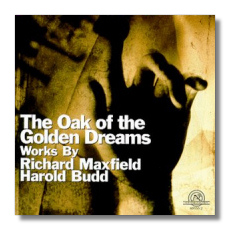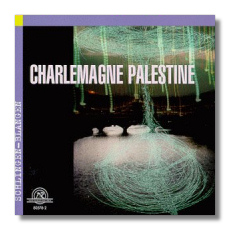
The Internet's Premier Classical Music Source
Related Links
- Latest Reviews
- More Reviews
-
By Composer
-
Collections
DVD & Blu-ray
Books
Concert Reviews
Articles/Interviews
Software
Audio
Search Amazon
Recommended Links
Site News
 CD Review
CD Review
Richard Maxfield, Harold Budd
&
Charlemagne Palestine

- Richard Maxfield:
- Pastoral Symphony
- Bacchanale
- Piano Concert for David Tudor
- Amazing Grace
- Harold Budd:
- The Oak of the Golden Dreams
- Cœur D'Orr
Various performers
New World 80555-2 ADD 66:46


- Charlemagne Palestine: Schlingen-Blängen
Charlemagne Palestine, organ
New World 80578-2 DDD 71:38
These two discs contain the work of composers who frolicked among the roots of minimalism in New York City during the 1960s. It was a time of experimentation, and Philip Glass and Steve Reich by no means were the only composers who were rebelling against European academics by trying out radical, stripped-down techniques.
Ironically, Richard Maxfield was a victim of the counterculture; he threw himself out of a window in 1969 – drugs are believed to have been involved. His most famous work probably is Night Music, an electronic work that appeared on an Odyssey LP with Steve Reich's Come Out and Pauline Oliveros's I of IV. Night Music is not on this CD (who will reissue it?), but four other highly contrasted works are. Pastoral Symphony (1960) is a brief electronic Prélude; if Beethoven is quoted, I can't hear it. It's a fetching landscape of rustling, murmurs, and muffled cries – the music of shifting tectonic plates and cellular processes. Bacchanale (1963) is a collage worthy of jazzman Ornette Coleman. Maxfield combines recordings of Korean and other folk musics with a hippy, trippy spoken monologue and Greenwich Village jazz. It'll have you snapping your fingers and scratching your head all at the same time. Cool! Pianist David Tudor is the performer-dedicatee in the next work, which Maxfield assembled in 1961. This Piano Concert asks the real-time pianist to play to the accompaniment of a tape of assorted piano "noises" in the Cage tradition: chains are dragged through the piano's interior, tiddly-winks rain down on the strings, and so on. Finally, Amazing Grace (1960) distorts vocal and electronic material (a revivalist's speech, excerpts from an earlier work of Maxfield's) by means of tape loops, and the result is a violent (at least to me) little drama.
Harold Budd has fallen under the New Age rubric in more recent years; the two works presented here date from 1969-70 and show a more provocative side of this interesting composer. Budd performs The Oak of the Golden Dreams on the Buchla Electronic Music System, an alternative to the Moog synthesizer. In this work, a shifting drone supports a flickering "right hand" improvisation that reminds me of Arabic music. The extended time-scale (18:44) definitely produces hypnotic, pleasant effects! Cœur D'Orr replaces the Buchla's dronings with those of the electronic organ and the Arabic flickerings with similarly free (at times more relaxed, at times almost gabbling) material for soprano saxophone.
Many of these recordings appeared as LPs on the Advance Recordings label. It was enterprising of New World to remaster and reissue them, and the results are excellent.
Budd's Cœur D'Orr should warm the listener up for Charlemagne Palestine's 72-minute pipe organ drone called Schlingen-Blängen. (If the title means something, I and commentator/composer Ingram Marshall are unaware of it.) For a time, Palestine shared a studio in New York City with Philip Glass. However, he wasn't closely aligned with any of the experimental composers of the 60s and 70s; his idiosyncrasies were more solitary. He loved the Bösendorfer piano, and he drew extended sonorities out of it through a sort of performance art which included stuffed animals (Palestine regarded these as spiritual) and free-form chanting and singing. When minimalism began to be accepted by the mainstream, Palestine all but ceased to be a composer/performer, choosing instead to focus his energies on the visual arts.
This recording, then, is something of an exception. It was made in 1988 in an isolated church in Holland, a decade after the composer had performed the work to an imported audience in the same location. Early in the 1970s, when he lived in Los Angeles, Palestine had access to a pipe organ and found it to be a useful medium for testing his artistic theories. What were they? Perhaps it is best to give an example. One day, while enraptured by the beauty of a particular passage in Debussy's music, Palestine remarked to Marshall, "If only it would stand still and stay that way for a long time." In Schlingen-Blängen, Palestine savors beautiful harmonies for minutes at a time. Essentially, the work is a 72-minute organ chord, varied only by the occasional addition or subtraction of notes, changes in registration, and, most remarkable, trompe d'oreille effects characteristic of the organ itself. Because of minor imperfections in tuning (that comes with the territory – almost no instrument is tuned perfectly), we hear that even a simple, sustained chord is neither simple nor sustained. The music beats and shimmers like a flock of birds filling up the church's emptiness. One could easily be fooled into thinking that Palestine was creating this motion through furious efforts on the keyboard, but the truth is that the organ doesn't need his help; paradoxically, a single chord creates more motion than the most intricate passagework. Palestine has little to do, but the music is always doing something.
Earlier in his career, Palestine performed his works in a kind of installation format which allowed listeners to come and go as they pleased. That's the best approach to take with Schlingen-Blängen. If you sit there and listen to it, you may go mad at first. (Not that that's necessarily a bad thing.) I recommend living inside the music and carrying on with your daily activities. It's hardly less insidious if you approach it that way, but it is more time-efficient. You might think that Schlingen-Blängen is a big joke. Maybe it is, but you can't help being fascinated by the crushing and sensual enormity of it all.
Copyright © 2000, Raymond Tuttle


















